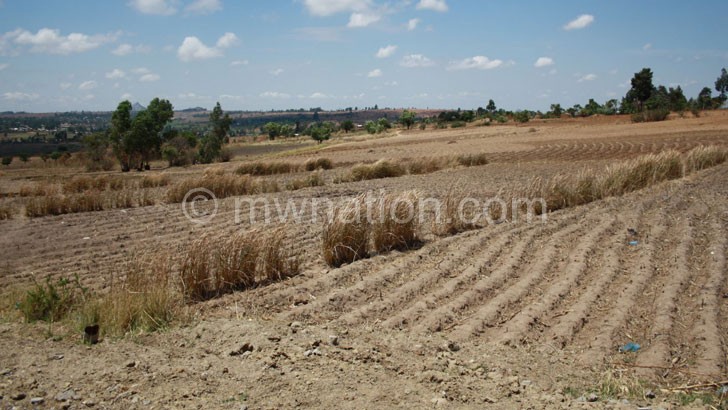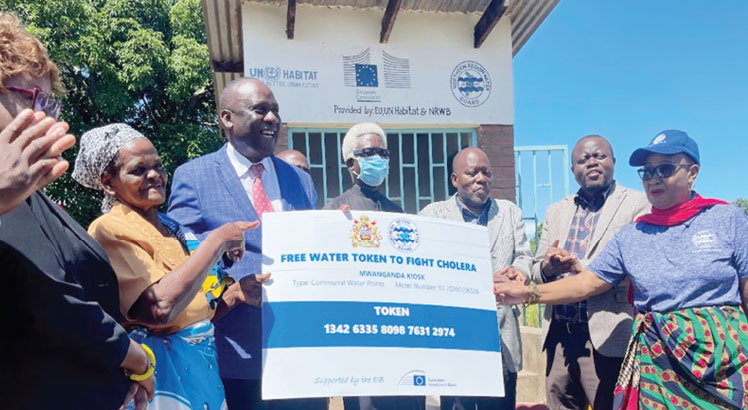Comesa responds to El Nino threat
As El Nino wreaks havoc on crops in Southern Africa, Fanny Manyowa’s maize field in Angonisathaonse Village, Traditional Authority Chigalu, Blantyre, stands as a testament to resilience.
The 56-year-old subsistence farmer has mastered the art of conservation agriculture, and it seems to be a winning strategy.

“For 10 years, I have practised conservation agriculture I have never been disappointed. My crops always look vibrant and promising,” explains the mother of six.
Covering her less-than-half-an-acre crop field with maize stalks and crop residues, Manyowa goes beyond conserving soil moisture—she also controls erosion.
The benefits of conservation farming, as she catalogues them, are extensive.
She says: “When a field has cover, raindrops do not hit the bare ground. The ground cover traps rainwater, significantly slowing runoff and giving it ample time to infiltrate. That controls soil erosion.
“When the ground cover decomposes, it turns into manure, adding fertility to the soil. This improves soil structure, aeration, water-holding capacity and increase microbial activities.”
According to Manyowa, this technology has tripled her harvest.

“On this small piece of land, I harvest about 15 bags of maize, each weighing 50 kilogrammes.
“In the past, I could rarely get five bags from the same plot,” proudly states the member of Nzeru N’chuma Farm Club.
Manyowa’s success is not a solo performance. Alongside the maize-stalk cover, some members of her club dig square pits, echoing the Pfumvudza farming method in Zimbabwe.
These 30-centimetre-long and 10-centimetre-deep pits become sanctuaries for four maize seeds at each corner, creating a harmonious blend of tradition and ingenuity.
In the tapestry of agricultural progress, experts assert that despite the challenges, these methods are transformative. Yet, amid the optimism, dissenting voices emerge.
Village head Lizzy Gonye from Domboswava Region in Zimbabwe acknowledges the potential game-changing nature of these technologies but observes that “despite their transformative potential, some farmers cling to the easy yet inefficient traditional farming methods in the face of climate change.”
El Nino
El Nino, according to National Geographic Education, is a climate pattern that describes the unusual warming of surface waters in the eastern tropical Pacific Ocean. El Nino is the warm phase of a larger phenomenon called the El Niño-Southern Oscillation.
The UN Office for the Coordination of Humanitarian Affairs (Ocha) as well as the National Oceanic and Atmospheric Administration (Noaa) explain that El Niño events occur irregularly at two- to seven-year intervals and are associated with droughts, flash floods, extreme hot weather conditions and devastative bush fires.
2015-16 El Nino
The 2015-2016 El Nino, classified as very strong by the Ocha, left an indelible mark on Southern Africa.
The region endured the worst drought in 35 years, and its repercussions resonated into 2017. Ocha’s report documented the severe consequences, including a food deficit, scarcity of pasture, and water shortages that resulted in the loss of 643 000 livestock.
Malawi, specifically, faced the brunt of the 2015-2016 El Nino, reporting 1 786 cases of cholera as of September 2016.
El Nino’s impact unfurls
Meteorological bodies within the Common Market for Eastern and Southern Africa (Comesa) are sounding the alarm on the far-reaching consequences of El Nino’s unwelcome visit to Southern Africa. Their predictions foretell impending droughts that will cast a shadow of widespread crop failures and the desiccation of vital water sources for communities, livestock, and wildlife.
According to the November 2023 Famine Early Warning Systems Network (Fews Net), countries such as Malawi, Zambia, Zimbabwe, Mozambique, Madagascar, Kenya and the Democratic Republic of Congo are slated to bear the brunt of El Nino’s impact.
The warning underscores the gravity of the situation, projecting below-average rainfall across much of Southern Africa and a subsequent dip in the 2024 harvest.
Fews Net estimates that over 20 million people will require food support during the peak of the lean season from January to March 2024.
The Centre for Agricultural Research and Development (Card) adds a dire economic perspective, predicting a staggering K337 billion maize yield loss for Malawi.
Card says El Nino will cause electricity load-shedding, water rationing and a decline in fish production.
Zimbabwe reports a grim toll on its wildlife, with five elephants succumbing to dehydration in Sinamatela, Hwange.
Zimbabwe National Parks Authority spokesperson Tinashe Farawo attributes these deaths to the early onset of migration driven by the water crisis.
The Hwange National Park is a vital part of the Kavango-Zambezi Transfrontier Conservation Area, spanning Botswana, Namibia, Zimbabwe, Zambia and Angola.
Comesa integration dream under threat
Amid this unfolding crisis, Christ-Citadel International Relief and Development agriculture expert Jean Pankuku issues a stark warning.
“El Nino directly impacts on Comesa objectives of increasing agriculture productivity and enhanced food security. El Nino induced poverty and hunger can also derail its objectives of promoting sustainable and inclusive development.
“Low food productivity in Southern Africa can lead to reduced intra-regional trade in agricultural products, hindering regional bloc’s goal of promoting economic integration.”
Expressing concern about the potential need for some Comesa member States resorting to food imports, she explains: “This will put pressure on foreign exchange reserves which could potentially impact their overall economic stability.”
She also highlights specific challenges faced by Kenya, saying: “In Kenya and Somalia, El Nino resulted in floods which have destroyed roads, bridges and railway lines, making it difficult to transport goods and services.”
This disruption in trade flows, according to Pankuku, will discourage investment in the regional trade bloc.
Aligning with these concerns, University of Zambia aquaculture lecturer Jonasi Wiza Ng’ambi asserts on Facebook: “El Nino will lower yields, increasing food prices and cases of malnutrition.”
While opinions vary, Lilongwe University of Agriculture and Natural Resources economist Dr Horace Phiri argues: “It is too early to predict El Nino’s impact. What we are experiencing is the dry spell, but things can change and we can have a good season.”
However, Malawi University of Business and Applied Sciences professor Betchani Tcheleni insists that El Nino will reverberate within Comesa.
He stresses: “Many African countries are agrarian. So, how can they trade with each other when they fail to harvest crops due to El Nino? For Comesa to flourish, member states must have goods and services to sell to each other.”
Tcheleni’s stance underscores the intricate link between agriculture, trade and the flourishing of Comesa’s integration aspirations.
Comesa’s commitment
Comesa Secretary-General Chileshe Kapwepwe echoes the region’s dedication to supporting member States in achieving a delicate balance between sustainable economic development and environmental protection.
“Given the increasing impact of climate change-related disasters in the Comesa region and particularly the effect of the recent Cyclone Freddy, which caused unprecedented levels of devastation, we have renewed our resolve to develop and implement programmes that address the effects of climate change, and which enhance the region’s preparedness,” Kapwepwe was quoted in Comesa News of January-March 2023 as having said after Malawi and Madagascar were hit by the devastating Tropical Storm Freddy.
She also echoed Comesa’s support for the outcomes of CoP 27 held in Egypt in 2022, urging all member States to fulfill their obligations in the collective fight against climate change.
Member States Response
Amid the looming threat of El Nino, governments across southern Africa assert that they have proactively implemented mechanisms to assist farmers in navigating the challenges posed by this climatic phenomenon.
Malawi’s Minister of Agriculture Sam Kawale affirms that his government is actively engaged in implementing adaptation and mitigation measures recommended by experts.
These strategies, encapsulated in a policy brief titled The 2023/2024 El Nino: Uncertainties and Opportunities for the 2023-2024 agriculture, form the cornerstone of Malawi’s response.
In Zimbabwe, Finance Minister Mthuli Ncube hints at the necessity to import maize.
Zimbabwe Farmers Union executive director Paul Zachariah and his Malawian counterpart Jacob Christopher Nyirongo have urged farmers to adopt conservation agriculture, irrigation farming, water harvesting technique, plant early to medium maturing maize varieties and follow good agronomic agricultural practices.
Across the region concerted efforts are underway to deploy technologies aimed at supporting farmers in their battle against the adverse effects of El Nino.
As these nations implement strategies to mitigate the impact, the race against time intensifies to safeguard agricultural productivity and ensure food security in the face of this formidable climatic threat.






One Comment